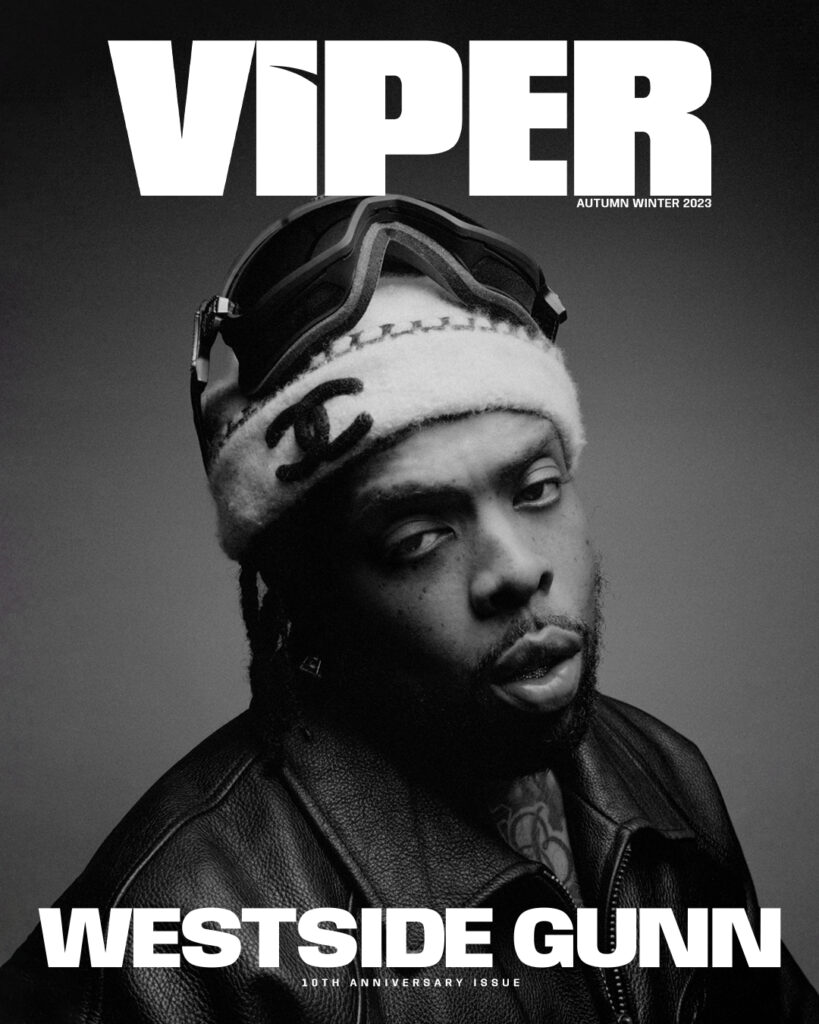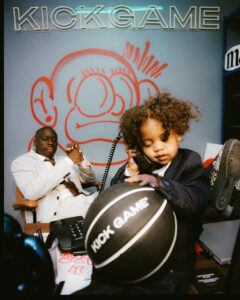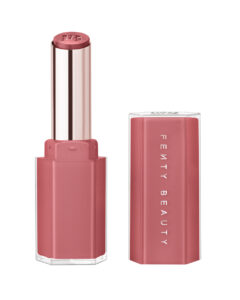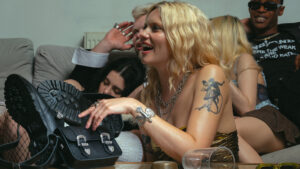To celebrate the launch of Coca-Cola’s Favour Parlour, we spoke to Sophia Hilton, the founder of Not Another Salon about her favourite flavour and cultural changes in hair…
Why was Coca-Cola the perfect brand for you to partner with for the Flavour Parlour?
They’re really fun and I drink Coca-Cola all the time; I drank so much Coke this week! I thought it was really good because they were relaunching Lemon and my entire personal brand is Lemon; that’s my colour. Because I had yellow hair for seven years, the idea of going back to Lemon for this launch, I just thought was really fun.
You’re modelling it very well but is that your favourite flavour of Coca-Cola?
No, I love vanilla.
Besides obviously my amazing vanilla hair, which was the favourite transformation you’ve worked on this week in the salon?
I really enjoyed the Cherries because I think it’s on trend right now and people are very, very excited to have the colour. I think the Cherry has been my favourite one because it’s quite achievable for most people. So we’ve been able to give it to them, which is really, really nice. It’s just gorgeous and shiny. Yeah, that’s probably my favourite; they’re gorgeous!
What was it about Lemon hair that made you keep it so long?
I went through a summer of having loads of bright colours – over the top of blonde, pink, purple. It was nice, I washed it off and just kept going through the whole rainbow. Then there was this moment where we put the yellow on, just on a whim. It wasn’t my favourite colour and then we pulled back the towel and the moment I saw my hair, I said that’s it; I knew it was my colour. That was for a whole seven years, until lockdown and it became everything, my whole branding. I’ve got my salon separate from my personal brand; my website and my Instagram. For my brand colours, everything’s yellow, it’s not even my favourite colour but it suits me.
Not Another Salon is about self-expression, what made you incorporate that message?
I was quite an outcast in my hometown, I was always a bit of a weirdo. But when I came to London, I still felt like an outcast and hadn’t found my little group yet. I don’t think I ever found that group of people that accepted me for who I was. So I guess I had to create it, I started to create this bubble around me of people that were really accepting of everything from your sexuality to your background to whatever whatever that might be. Then I started expanding out of that bubble so that when people came in these walls, they were away from pressures, they’re away from any judgement, they can be who they want. A lot of people say they’re No Judgement spaces, but I think actually having a no judgement space is actually quite a challenge. It’s something that we’ve personally worked on for years.
In the last decade, we’ve really seen a change in people able to be themselves without question. Did you feel like a community came naturally with that or was it something that you consciously created?
Yeah, when it came to bright colours, they were only for alternative girls or Camden girls or boys or whatever. It wasn’t particularly commercial and I wanted Deborah from the local legal office to be able to wear blue hair as she wants. In the past 10 years we’ve been challenging why can’t you wear these colours in a normal workplace? It’s not just for a star, it can be for anyone. I think we’ve really broken the back of that, we’ve still got a long way to go, but we have made changes. Pink is the new neutral, when someone had pink hair 20 years ago, you’re like, “they’ve got pink hair!” Now, someone comes in with pink hair and you don’t even comment on her. It’s not that out there anymore, we’re working through the rainbow and hoping that’ll expand in the next 15 years. People don’t care so much.
Have you seen a change in the clientele you attract?
If you look at my salon, it looks very loud and fun, so the misconception is that my clients are really out there, they’re these extroverted characters; it couldn’t be further from the truth. 75% of my client base are not extroverts. We have a lot of people with neurodiversity here, a lot of people have mental health issues. People are looking to try and express what’s on the inside, on the outside. So for them, this is a huge step! The first time they come they’re in tears, looking in the mirror like “I finally did it!” It’s a different client base.
You might expect a salon like this to enforce a style on a client and then they leave and the look feels too extreme for real life. But it’s the opposite, you really embrace making people feel like the best version of themselves. How did you hone that?
It took me a long time to admit this, I don’t give two shits about fashion; I really don’t care. I pretended that I care about fashion, I wrote trend reports for fashion magazines for years and I can do it. But actually, my own style is very much just based on what I love at the time. It’s only through age and confidence – and getting to the top of my game – that’s allowed me to be like, “I care the most about the human sitting in the chair.” I don’t really care if this tone is on trend, what I care about is, how you feel you look so I’ll always put humans first and trends second. The only thing that I do like is cultural change, that’s the kind of fashion I’m interested in; not fashion for fashion’s sake. But for example, when people with textured hair start wearing their hair out more; that inspires me. That’s super exciting! That’s not a trend, that’s cultural change and I’m inspired by that. I’m inspired by people wearing more vivid colours in the workplace. It is fashion but it’s also a cultural change. It’s taken me a decade to understand, I do care about fashion but it’s that area that inspires me the most. When it means something.
That’s what’s leading the change, not following it.
Exactly, I think I always felt guilty for not knowing enough about that stuff. I worked for some amazing brands before and when I opened [Not Another Salon], we started dancing to the beat of our own drum and we made trends. We’ve had trends go viral all over the world, we’ve been on MTV and we’ve done every fashion magazine. With yellow hair, I was the face of Valentino for a whole shoot in Vogue and I don’t even read Vogue. I could never even read it, I’ve literally never read it and Pier Paolo came in here and then chose me. We were just here doing our own thing and I’m really proud of that; we were on This Morning last week. It took me years of being really sad and feeling like I don’t fit in and then suddenly people have started to recognize we’re leading the trends in that way, which is cool.
It feels to me like there’s no subcultures anymore but instead of everyone looking the same, everything’s splinted and so there’s a microcosm of trends. How does that affect what you do creatively here?
It’s a lot less interesting than that when it comes to vibrant colours. A lot of it is on practicality like, “Do you want to be like this for the next two years or the next two weeks?” That will decide what colour we go for so sometimes it’s not even that deep. It’s actually like, “is this an expression of you for a period of time? Or is it longer?” That will decide what direction we go, a mixture of trends and stuff like that. By the way I agree with you, I’ve really noticed this [loss of subcultures]. The last 10 years, I’ve loved watching sportswear become really high fashion because I hated sportswear and now I like it. We had a BBC show as well [Misfits Salon], it’s on iPlayer and the idea was that we wanted to try and express what was on the inside on the outside of that person like outside of trend. We had this girl, I mean this respectfully but she was quite dowdy in the way she dressed; kind of hunched shoulders. She had a physical illness and she very much made herself smaller and she bought quite dull clothing yet she was a really wild cosplayer at the weekend. She had these most amazing costumes and our job was, how do we bring your cosplay personality into your everyday life because you don’t have to pretend to be someone else. Because that is part of you and basically we created this daily cosplay version of herself which was really cool. And a lad coming out for the first time, wondering what his new dress sense is going to be, what does that look like? All of that stuff, helping them explore it. Although, his story was really funny because once we dressed him all up, he said “oh no, actually I think I just fancy boys that look like this. I don’t want to look like this.” But that is also a big part of working out who you want to be. Is it that I’m attracted to those people or do I want to be that person?







How do trends play into your creations?
I obviously am influenced by Trends because I’m on Brick Lane. So, subconsciously, I’m constantly seeing students mismatching weird clothing and I’m really lucky to be able to see these visuals all the time. Some of which are great, some of which are very experimental and they’ve not worked it out yet. It’s great that they’re playing around with clothes, isn’t it? Love it.
What are the favourite trends that you’ve pioneered?
In the early days, in The Metro… it kind of went everywhere! It was vivid colours with polish because vivid colours had only been done in a grunge way. So it was taking bright colours and making them look expensive. That was probably the core trend that we changed. We also had a viral hidden rainbow that went everywhere. It was in 25 countries or something and I’m not a big fan of rainbows. But they pick up on one image and then everyone copies everyone. The Hidden Rainbow was a rainbow panel underneath the hair and the reason why I didn’t love that going viral… when I say viral, I don’t mean just one post did really well, I’m talking about all the magazines globally and it was in Japanese! But the point of the company I was trying to create was one a bit more commercial, a bit more beautiful and two, it wasn’t about hiding who you were. I didn’t want you to have to hide it at work, I wanted you to be loud and proud and it was a little bit against what I was trying to prove at the time, but you don’t choose what goes viral sometimes. It didn’t have anything to do with pride or anything like that, the world just went wild for it. I was just constantly doing interviews, I was coming out of the doctors and I got called by the BBC to do a live interview. I was like, “it’s just a rainbow man!” At the moment, we do silent haircuts so that’s why we were on This Morning and then we went on the radio. We created that in 2017 but a salon in Helsinki has just gone silent and they’re getting a lot of credit. Once the journalist did a little bit of research, they saw it came back to us. So then people started ringing us again.
When did you realise it’s important to cater to neurodivergence?
I’d have a client come in and they’d write down what they want with their hair and then they’d hand it to me on the table and keep their head down, giving me no eye contact, clearly struggling with the conversation, usually from quite extreme anxiety. The reason why I came up with it, is because I started getting my hair done in other salons because we were too busy – I know what a flex. Then when I go in, because I know I’m a hairdresser as well and I’m a chatty person, we’d end up waffling the whole time. But when I thought about it, if you’d given me the option before I walked in the door and said, “would you like a silent service?” I probably would have chosen it. Now a lot of hairdressers, they’ll say, “oh, if you’re a good hairdresser, you should know when someone wants to stop talking.” If I sat in your chair, you wouldn’t know I don’t want to talk because I’m just going to start talking. I’m going to lead the conversation because that’s just what I’m like. That could be because I’m anxious or it could just be because I’m ADHD and I’ll talk a lot anyway. But actually I just want to relax and people find it very difficult to say, they don’t want to talk. Why do we find that difficult?
I think it’s more about not offending than it’s about how you feel in a way.
Yeah, The Guardian just did a massive article, I think they just did it because it’s argumentative and fair enough… saying what has happened to society that we’re so arrogant that we can’t even talk to our hairdresser anymore? It was really aggressive, it definitely needs a counter argument. I skim read it because someone sent it to me but they were going, “what has happened to the young society where we can’t even have a bit of Chit Chat? We’re too up ourselves now!” But obviously it’s not about that. Also a hairdresser is on the floor, five days a week, talking for eight hours a day, we’re tired as well! So if Aaron gets booked in for a silent haircut at three o’clock after a busy day, he’s like, “yesssss!” I went past an afro barbers in Dalston the other day and [the barber] just had big earphones on; I love that! I don’t know what the conversation he has with his client is, but I love the idea that he’s like, “I’m gonna tune out to a podcast now mate, is that all right?” Or maybe it might be that he struggles with lots of outside noise, there could be so many different things. Whatever it is, I love that he’s doing it for him.
I read a lot of hairdressers have mild PTSD from listening to clients discuss bad aspects of their lives. How do you protect your staff?
Trauma dumping. Something we never talked about 15 years ago in the industry. Obviously now people are more aware of how they’re feeling, young people are more in touch with their emotions and their feelings, rather than packing it away in a box. I teach a lot of seminars on intergenerational management, that’s my main topic; I travel the world, teaching how to manage the different generations. But yeah, they’re more aware of what it’s doing to them. I think it’s about pairing the right customer with the right person. Some people have a bigger capacity for it. One of my stylists just can’t cope with it, he hates it. He’s like, “I can’t take on that energy.” Whereas I like it. I don’t like to chit chat about celebrities and stuff, I’m like, “let’s go into your divorce.” I’ve got a stylist here, she’s only in her early fourties but she’s already a nan. If you want to talk about all the heavy lifesty stuff, she’ll talk about that till the cows come home! She’ll go there with the dark stories but it’s not my program.
As much as we’ve been breaking down racial segregation in the UK, the hair industry is still so segregated. How are you implementing change with Not Another Salon?
It’s funny because there’s quite a lot of nail salons that were really pushing the fact that they were so inclusive but our fingernails are exactly the same so they don’t have the same challenges. Some hairdressers use the excuse, “we didn’t get it taught at school.” My answer is, “you didn’t get taught hair extensions, but you’re fucking good at them aren’t you?” So we can all learn, I grew up in a predominantly white area in Blackpool, no afro clients. By the way, we use “Textured” and “Afro” interchangeably in the UK. I worked for a predominantly white salon with no people of colour in the salon at all. I didn’t think anything of it, opened a salon and never said, I wanted the salon to be inclusive. Never use the word inclusive, it wasn’t a buzzword at the time; all I said was I wanted it to be welcoming for everyone. But the truth is, if someone was coming in with a certain texture of hair and I didn’t have that right member of staff, I would have to tell them I don’t have appointments for them. Which is shit, isn’t it? So in 2019, the salon started on a program learning textured hair, starting from a wider curl and we were going tighter. In 2021 or 2022, we started offering afro courses to teach other hairdressers how to do it. It’s great for us because we’ve always got afro education going on, I’ve got a new Junior so I can send them on the courses. I’m not doing them myself, I’m passing that over to people that can do it better. But on my personal journey, I’ve been doing models for free. At least every three months for about four years now. Bearing in mind, I make about a thousand pounds a day, if I take up half a day, it’s a big chunk of my money and time. But I want to take the shame away from the other white hairdressers who can’t do afro hair and say, “let’s just take the first step.” But the biggest thing is language, it’s not the hair; hair’s easy. It’s understanding black history, that’s the thing that we need to learn the most and that’s what we enforce. So our courses are not just about how to handle the hair but how to understand things like you probably got touched a lot as a child and you got patted. That’s really important to understand a little bit about how it might have been at home if you had a white mum who didn’t understand your hair type and how difficult that might have been. The other part that I’ve been learning a lot about, is understanding that for people my age and up – I’m 36 – the idea of wearing your hair out can be really frightening. Actually if I get a woman wearing her hair out for the first time, she’s in tears while a 20 year old is a lot more relaxed about it. There’s definitely a difference, even in just 10, 15 years of how people feel about wearing their hair out. Knowledge of the culture is equally important as the hair itself and if I want you to feel like you can trust me, I need to talk to you about those things so I know your history. Once I’ve had those conversations, once I start asking those cultural questions, my clients will get the impression that I understand them and then they relax. They’ve usually had their hair buggered up by a lot of white hairdressers, so they’re scared. It’s been a really nice journey, even for me, to now have textured hair in front of me and just have no worries.





